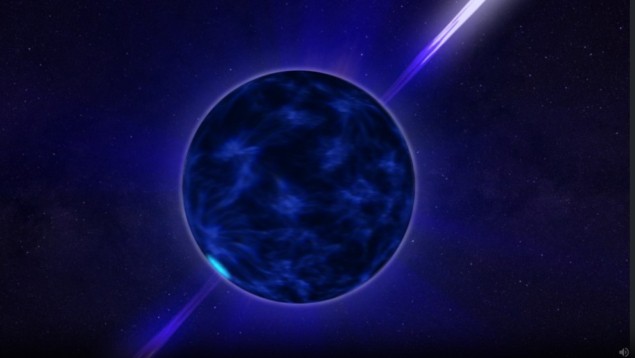
A team of theoretical physicists in India has shown that gravitational waves could reveal the role that dark matter could play in transforming neutron stars into black holes.
Dark matter is a hypothetical, invisible substance invoked to explain the curious behaviour of large-scale structures such as galaxies and galaxy clusters – behaviour that cannot be explained by gravity alone.
If it exists, dark matter must interact with ordinary matter via gravity. However, some models predict that dark matter could also interact with ordinary matter through very weak non-gravitational interactions.
Feeble but sufficient
“Non-gravitational interaction means that [dark matter particles] are expected to have some sort of interaction with protons and neutrons,” Sulagna Bhattacharya told Physics World. Bhattacharya is a graduate student at the Tata Institute of Fundamental Research in Mumbai, who adds, “These interactions may be very feeble, but they may be sufficient enough to allow the dark matter particles to become captured inside a neutron star”.
Neutron stars are the dense core remnants of massive stars that have exploded as supernovae. They are very small, perhaps a dozen kilometres across, but with masses greater than the Sun. The core of a neutron star is so dense that it could increase the probability of interactions between normal matter and dark matter.
The maximum theoretical mass that a neutron star can have is 2.5 solar masses, but in practice most are much smaller, around 1.4 solar masses. Neutron stars that are greater than 2.5 solar masses will undergo gravitational collapse to form black holes.
Closing the gap
Stellar mass black holes can also form directly from supernovae (explosions of large stars), but theoretical modelling has suggested that black holes should not exist at 2–5 solar masses. Until recently, this was supported by observational evidence. However, beginning in 2015, observations of gravitational waves from the mergers of black-hole pairs revealed the existence of black holes within this mass gap.
For example, GW 190814 was a gravitational-wave event detected in 2019 that involved an object with between 2.50–2.67 solar masses. Another mystery event was GW 190425, also detected in 2019, wherein the combined object had a mass of 3.4 solar masses. This is a substantially higher total mass than any known binary neutron star system.
Now Bhattacharya, her supervisor Basudeb Dasgupta, plus Ranjan Laha of the Indian Institute of Science and Anupam Ray of the University of California, Berkeley, have suggested that dark matter accumulating within the core of a neutron star would increase the core density to the point that it collapses into a miniature black hole. This black hole would then grow and engulf the neutron star. The result would be a black hole with a lower-than-expected mass. And, the detection of such low-mass black holes would be tantalizing evidence for the dark matter.
“Astrophysically exotic”
“These compact objects would be astrophysically exotic,” says Bhattacharya, who is the lead author of a paper describing this hypothesis in Physical Review Letters. Their paper puts forth GW 190814 and GW 190425 as mergers that could have involved black holes that were made with the help of dark matter.
Whether black holes converted from neutron stars exist or not, Bhattacharya says that searching for them will provide, “some significant constraints on dark matter interactions with nucleons”. As a result, the growing number of mergers being observed could allow physicists to evaluate different models of dark matter.

Stars powered by dark matter may have been seen by the JWST
Another possibility is that the low-mass objects observed in GW 190814 and GW 190425 are primordial black holes that formed in the immediate aftermath of the Big Bang. However, some theories suggest that primordial black holes could be a component of dark matter – so studying mergers could provide even more information about the nature of dark matter.
Indeed, the key advantage of using gravitational waves to search for evidence for dark matter is that it is the most sensitive means we have for detecting the faint non-gravitational interactions of dark matter with normal matter.
This is because observing gravitational waves is not subject to the “neutrino floor”, which limits experiments that aim to directly detect dark matter. The floor refers to the fact that neutrinos are a significant source of background noise in dark-matter detectors such as LUX-ZEPLIN.
“The method suggested by us can probe the regions that are beyond the reach of these terrestrial detectors due to limited exposure and detector sensitivity,” says Bhattacharya.
- SEO Powered Content & PR Distribution. Get Amplified Today.
- PlatoData.Network Vertical Generative Ai. Empower Yourself. Access Here.
- PlatoAiStream. Web3 Intelligence. Knowledge Amplified. Access Here.
- PlatoESG. Carbon, CleanTech, Energy, Environment, Solar, Waste Management. Access Here.
- PlatoHealth. Biotech and Clinical Trials Intelligence. Access Here.
- Source: https://physicsworld.com/a/gravitational-waves-could-reveal-dark-matter-transforming-neutron-stars-into-black-holes/



